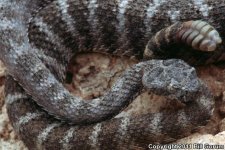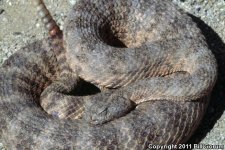| Range: |
 |
| Other Names: |
|
| Description: |
The Tiger Rattlesnake (Crotalus tigris) is a moderately-sized (< 959 mm TL), heavy-bodied snake with 34-52 dorsal crossbands on the body that are somewhat darker than the gray, bluish-gray or yellowish-brown to pinkish or slightly orange background color. Crossbands anteriorly on and near the neck may form blotches. Four to ten crossbands are present on the tail that are similar in color and form to those on the body. A series of small, dark lateral blotches, particularly anteriorly, alternates with the dorsal crossbands, and the crossbands may have a dark spot on their lateral edge. The venter is cream, tan, yellowish, greenish-brown, to pink with scattered darker mottling and spots. Atop the head are often dark blotches or markings that may be indistinct, or the head may be unmarked (Grismer 2002, Ernst and Ernst 2012, Goode et al. 2016).
This snake has an unusually small head and large rattles. The head length is less than 2.5 times the maximum diameter of the basal segment of the rattle. The broader than long rostral is in contact with the anterior nasal scales and the upper preoculars are undivided. Usually there is one (rarely 2) loreal scale, 11-16 supralabials, and 11-16 infralabials. The dorsal scales are heavily keeled and occur in 20-31 rows at mid-body. The subcaudals are undivided. The longest males are longer than the longest females (775 mm TL) and neonate Tiger Rattlesnakes resemble adults in color and pattern (Goode et al. 2016). Adult males have significantly longer tails than females, and that character is reliable for sexing Tiger Rattlesnakes (Goode et al. 2016). |
| Similar Species: |
This rattlesnake's distinct pattern separates it from other rattlesnakes in New Mexico. |
| Venom: |
Venomous - Venom yield is relatively low, but the toxicity of Tiger Rattlesnake venom is high. Although little is known of the effects of the venom on humans, any bite from this species should be considered life threatening. |
| Habitat: |
The Tiger Rattlesnake is a species of rocky slopes and bajadas. |
| Behavior: |
Most Tiger Rattlesnakes are active at night, but some crepuscular and daytime activity occurs as well (Duvall et al. 1996, Brennan and Holycross 2006). Tiger Rattlesnakes are only very rarely observed above the ground in shrubs or trees. |
| Hibernation: |
Tiger Rattlesnakes have been found to stay close to rocky habitats in winter and early spring, but venture downslope into washes and bajadas later in the spring and during the summer rainy season (Beck 1995, Goode et al. 2016). These snakes enter winter dens from October to December, and then emerge in March or April (Duvall et al. 1996, Cochran and Goode 2012). |
| Reproduction: |
Mating occurs from early July to late September or October. Males have occasionally been observed in combat wrestling matches during the summer. Adults measure > 512 mm SVL (males) and > 521 mm (females, Goldberg 1999, Goode et al. 2016). Females give birth to 2-6 young from late June into September. Neonates measure 210-258 mm TL (Ernst and Ernst 2012). |
| Diet: |
Tiger Rattlesnakes have been found to feed upon a variety of rodents and lizards. Birds are occasionally taken (Amarello and Goode 2004, Goode et al. 2016). |
Adapted from the species account at Tucson Herpetological Society
|



















